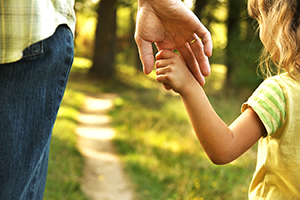 1. When planning family travel and outdoor activities, include telling young children what to do if they lose sight of you. (Avoid the word “lost;” It seems to scare children.) Generally, young children panic when they don’t see you and realize that they are in an unfamiliar setting. They look all around and then run as fast as they can in whatever direction they happen to be facing. This greatly complicates retrieving them. Being lost is an extremely frightening experience for young children, often remembered into adulthood.
1. When planning family travel and outdoor activities, include telling young children what to do if they lose sight of you. (Avoid the word “lost;” It seems to scare children.) Generally, young children panic when they don’t see you and realize that they are in an unfamiliar setting. They look all around and then run as fast as they can in whatever direction they happen to be facing. This greatly complicates retrieving them. Being lost is an extremely frightening experience for young children, often remembered into adulthood.
2. Teach them to stay put when they don’t see you. Tell them that you will be right back. The “Hug a Tree” program teaches them to literally hug the nearest tree, enabling you to retrace your steps to reunite. Hugging a tree may also help reassure them that the situation is under control. Or teach them “Freeze,” a game in which children run about until a designated caller yells, “Freeze!” The children stop in their tracks (freeze) and remain in place until someone gives the all-clear signal. Play this game with them.
3. Or tell them to approach “another mommy” (a woman with a young child). Mommies are easily identifiable by young children and easy for them to relate to. Telling them to approach security personnel and police officers is obviously OK, but such people may be more difficult for young children to identify and to feel comfortable with.
 4. Try not to frighten children when speaking to them about “becoming separated.” Intermingle your message with reminders of the fun they will be having wherever you are going. Tell them that sometimes you, the parent, can become separated from them, and that if that happens you will return promptly. And don’t scold them when you find them. Use the situation as a teaching opportunity. Tell them what you and they did wrong to have created the predicament.
4. Try not to frighten children when speaking to them about “becoming separated.” Intermingle your message with reminders of the fun they will be having wherever you are going. Tell them that sometimes you, the parent, can become separated from them, and that if that happens you will return promptly. And don’t scold them when you find them. Use the situation as a teaching opportunity. Tell them what you and they did wrong to have created the predicament.
 5. Envision situations where separation may occur. Elevators are one example. Children run into elevators as soon as doors open, and the doors may close before you get in. They should hold your hand when entering. Should they find themselves riding alone, they should remain in the elevator until it returns to your floor. Otherwise, they usually get off as soon as the door reopens, often on another floor. Pressing the elevator button will return the elevator to your floor eventually.
5. Envision situations where separation may occur. Elevators are one example. Children run into elevators as soon as doors open, and the doors may close before you get in. They should hold your hand when entering. Should they find themselves riding alone, they should remain in the elevator until it returns to your floor. Otherwise, they usually get off as soon as the door reopens, often on another floor. Pressing the elevator button will return the elevator to your floor eventually.
6. Pin identification tags on young children. In crowded areas attach a tag with your cell phone number to the child’s outer clothing. Law enforcement officials say such identification speeds reuniting parent and children, and in no way encourages abduction. Random abduction of children from public places is an extremely rare occurrence, says the FBI, and is usually committed by family members. Stories that this happens frequently at amusement parks, airports, and other such venues are untrue.
 7. Place a leash on toddlers. You may get some disapproving stares and, rarely, some uncalled for sarcastic remarks from total strangers, but leashes do prevent toddlers from wandering off. They are especially helpful if you have an active child or more than one toddler in your charge.
7. Place a leash on toddlers. You may get some disapproving stares and, rarely, some uncalled for sarcastic remarks from total strangers, but leashes do prevent toddlers from wandering off. They are especially helpful if you have an active child or more than one toddler in your charge.
8. Electronic surveillance systems allow you to “see” your children when you cannot. Most consist of a transmitter and receiver. Transmitters are lightweight, may resemble small teddy bears, and attach to a child’s clothing. You hold the receiver. Transmitters send signals if a child wanders further than a predetermined distance. Receivers have maps that display the direction and distance of the location where the child is at that moment, and may have a beeper that becomes louder as you approach the child. Some receivers can activate the transmitter to set off a loud alarm to alert adults in the vicinity of the lost child.
 9. For older children, check that they understand where you will meet them. They may not be listening when you tell them, especially if they are excited about the place you are visiting. Write down the meeting point and see that they put the paper into their pocket. Check out the meeting point. Stores and arenas may have more than one exit. Landmarks change from one visit to the next. Many amusement park rides have exits not in view from the entrance. Cell phones are invaluable for helping older kids reunite after becoming separated. In wooded areas consider supplying them with a whistle.
9. For older children, check that they understand where you will meet them. They may not be listening when you tell them, especially if they are excited about the place you are visiting. Write down the meeting point and see that they put the paper into their pocket. Check out the meeting point. Stores and arenas may have more than one exit. Landmarks change from one visit to the next. Many amusement park rides have exits not in view from the entrance. Cell phones are invaluable for helping older kids reunite after becoming separated. In wooded areas consider supplying them with a whistle.
 10. Report missing children to security officials immediately. Don’t spend time searching alone. Most public places have protocols for missing children alerts including security personnel with two-way radios and surveillance cameras. Report back to security when you find your child. Dressing children in items that stand out in crowds helps find them. If you have more than one child, dress them identically. And once they are dressed for the day’s outing, take a picture of them so that you can show security personnel in the event you become separated.
10. Report missing children to security officials immediately. Don’t spend time searching alone. Most public places have protocols for missing children alerts including security personnel with two-way radios and surveillance cameras. Report back to security when you find your child. Dressing children in items that stand out in crowds helps find them. If you have more than one child, dress them identically. And once they are dressed for the day’s outing, take a picture of them so that you can show security personnel in the event you become separated.

